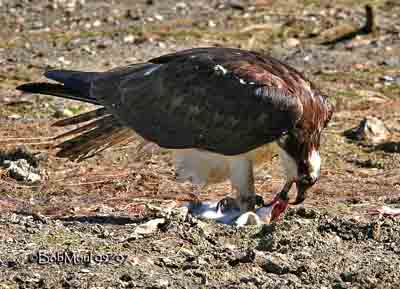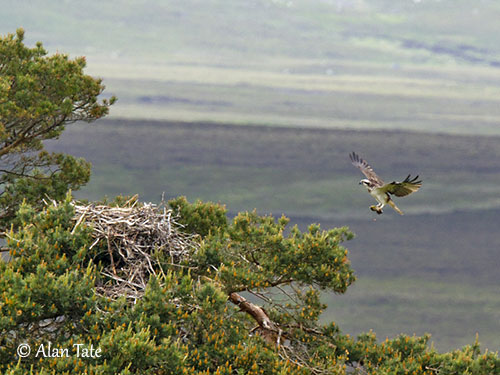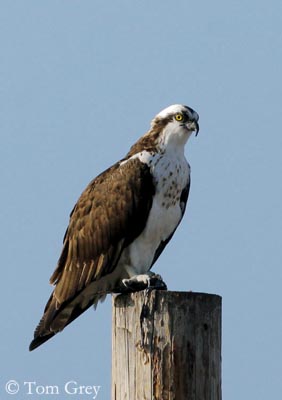
Osprey
Pandion Haliaetus
Accipitriformes Order – Pandionidae Family
BIOMETRICS:
Length: 54-58 cm
Wingspan: 150-180 cm
Weight: M: 1200-1600 g - F: 1600-2000 g
DESCRIPTION:
Osprey is a large bird of prey.
It has dark brown plumage on upperparts.
Underparts are white, with dark brown small spots on upper breast, as a necklace.
Fr: Balbuzard pêcheur
All: Fischadler
Esp: Aguila Pescadora
Nd : Fiskeørn
Russe : Скопа
Sd : Fiskgjuse
Photographers :
Alfredo Colón
Puerto Rico Wildlife
Tom Grey
Tom Grey's Bird Pictures
Paul Guillet
Photos d’Oiseaux
Patrick Ingremeau
TAMANDUA
Tom Merigan
Tom Merigan’s Photo Galleries
Bob Moul
Nature Photography
Jean Marc Rabby
Des Ailes et des Plumes
Alan & Ann Tate
AA Bird Photography
Text by Nicole Bouglouan
Sources :
HANDBOOK OF THE BIRDS OF THE WORLD Vol 2 by Josep del Hoyo-Andrew Elliot-Jordi Sargatal - Lynx Edicions - ISBN: 8487334156
GUIDE DES RAPACES DIURNES – Europe, Afrique du Nord et Moyen-Orient de Benny Génsbol – Delachaux et Niestlé – ISBN : 2603013270
HAWKS, EAGLES AND FALCONS OF NORTH AMERICA by Paul A. Johnsgard - Smithsonian Institution Press - ISBN: 1560989467
THE COMPLETE BOOK OF BRITISH BIRDS – Written by “Royal Society for the Protection of Birds” experts - Préface de Magnus Magnusson - Michael Cady- Rob Hume Editors - ISBN: 0749509112
LES AIGLES par Maurice Dupérat - Artémis Editions - ISBN: 2844164536
The Birds of North America online
Wikipedia (Wikipedia, The Free Encyclopedia)

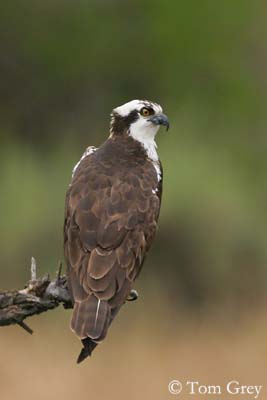
Tail is brown barred with white. Long wings are white below, with dark brown patch at the carpal joint.
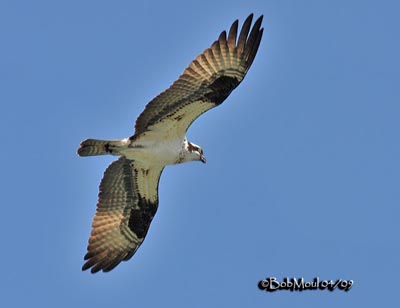
Head is white, with conspicuous dark brown eye-stripes. We can see longer feathers on nape.
The hooked bill is black. When the bird dives, the nasal valves prevent the water entering the nostrils. Eyes are yellow. Legs and feet are pale blue-grey.
The Osprey is a fish-eating raptor which shows a particular feature (shared with the owls), the opposable toe. Most of raptors have three toes forwards and one backwards, but although the Osprey has the same type of foot, it is able to change this configuration for better catch.
The outermost (the smallest toe) is positioned with the rear one, giving the following arrangement of two forwards and two backwards.
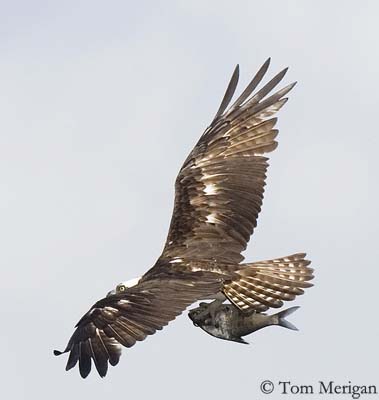
In addition, the Osprey is able to grasp slippery fishes thanks to the pads covered in spines which are on the soles of the toes, and to the sharply curved talons similar to fish hooks. It can grip firmly the fish.
Both sexes are almost similar in plumage, but female is slightly larger than male, and has darker streaking on upper breast, and darker plumage.
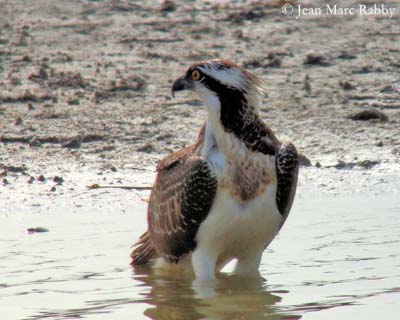
Juvenile has dark brown plumage, with pale buff edges above. It has duller brown plumage than adult female. Its breast’s necklace is not very conspicuous. Eyes are orange-red, not yellow.
Some variations in size and colour can be observed. Tropical and subtropical birds are smaller than those from higher latitudes.
We can find 4 subspecies which differ in size and plumage:
P.h. haliaetus
P.h. carolinensis, slightly larger and darker.
P.h. ridgwayi, paler above and on head and breast, than previous.
P.h. cristatus, smaller, with dark breast band and fairly pale crown.
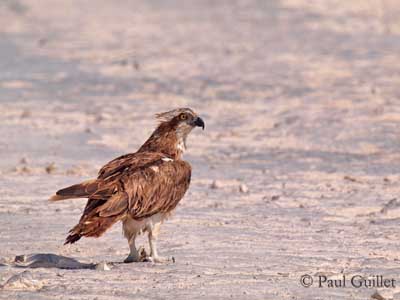
VOICE: SOUNDS BY XENO-CANTO
Osprey is usually silent, but they use vocalizations for begging food, alarm, during courtship and defence displays.
Alarm call is a series of hoarse and descending whistles “piu-piu-piu-piu”. During the flight displays, the male utters a series of mournful whistles “yeelp-yeelp-yeelp”. And we can hear series of loud whistled “kyews”.
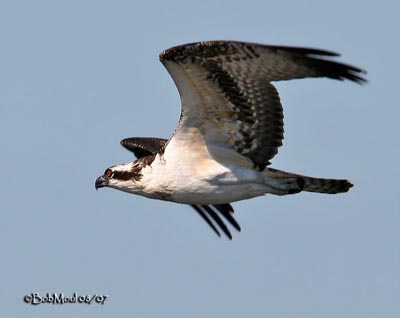
HABITAT:
Osprey needs shallow water and safe nesting sites. We find it in freshwater or brackish lakes, lagoons, estuaries and rivers.
It nests in adjacent forests, but in some parts of its Mediterranean range, it breeds only on sea coasts, on cliffs or small islets.
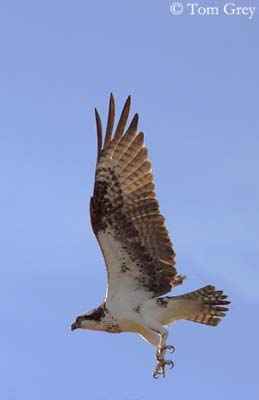
RANGE:
Ospreys have a worldwide distribution, except Antarctica. They breed in North America, Eurasia (when migratory), Middle-East, North Eastern Africa, Australia and Indonesia. They may be migratory or sedentary.
They winter southwards to South America, Africa, India, Southern Asia and Australia.
BEHAVIOUR:
Osprey feeds on fish, captured in shallow waters, or near the surface in deeper waters. Osprey hunts for fish on the wing, flapping and gliding at about 10 to 40 metres above the surface. When it locates a prey, it hovers briefly, and dives towards the surface. Just before to hit the water, it swings its legs forwards and bends the wings backwards, and plunges feet-first into the water.
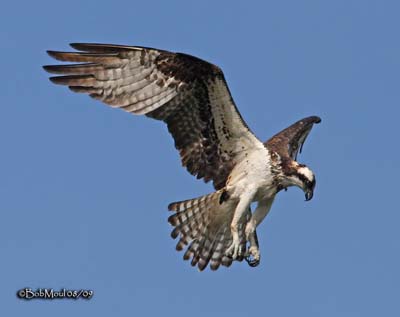
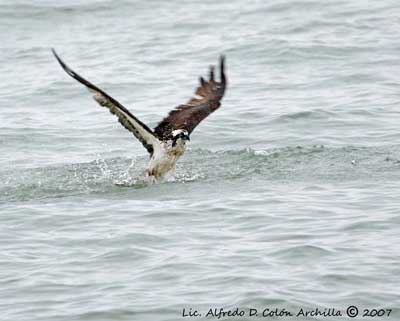
Then, Osprey carries the fish with one leg in front of the other, to put the fish face forwards, it is easier to carry it.
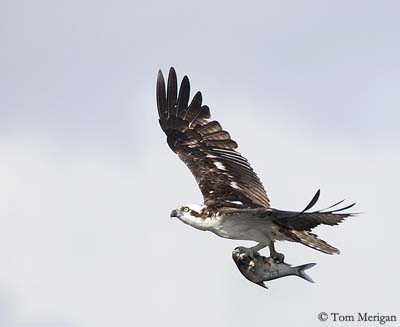
Osprey brings the fish to a perch for eating. Usually, it begins with the head and continues towards the tail.
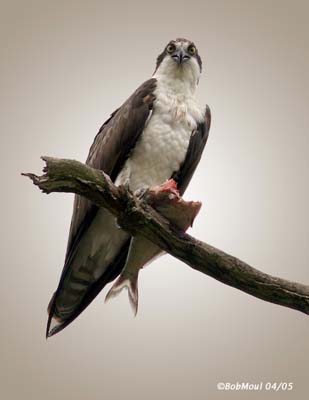
Breeding season differs between populations. Non migratory birds breed in winter and spring, and migratory birds breed in spring and summer.
Male performs elaborate aerial displays during courtship and just before the laying. One of these flight displays is named “sky-dance”. Male brings a fish or some nest materials. It gives screaming calls while it performs undulating flight alternated with hovering.
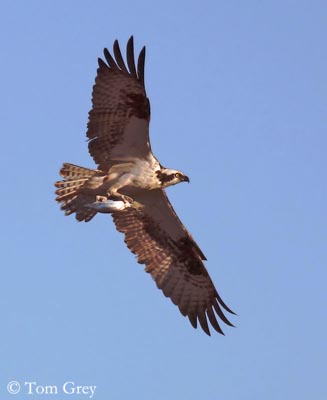
Osprey defends its nest or nest-site, giving alarm calls when predator, intruder or disturbances (boat or humans) approach the nest. It also adopts an erect posturing and diving flight.
FLIGHT:
Osprey soars less often than most raptors. It glides with well raised arms and hand lowered. When it performs active flight, it has powerful but loose and shallow wing beats.
To carry its large prey, Osprey uses strong, horizontal wing beats to lift itself and the fish from the water. Sometimes, it may be difficult for him to take off from the water with very wet plumage.
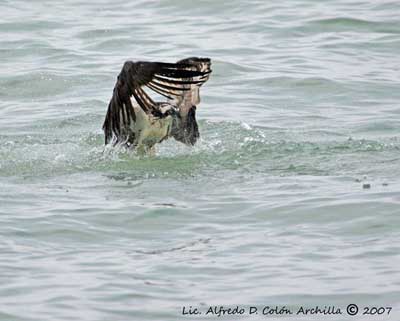
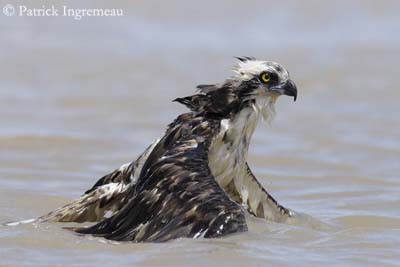
This one with very wet plumage was unable to take off. It has been rescued by a birders’ group.
REPRODUCTION:
Osprey’s nest is located in dead tree or artificial nest platform. But it can nest on man-made structures such as poles, towers, buildings and others. They need structures that can support the bulky nest.
Both sexes collect materials. Nest is made with sticks, and lined with soft materials such as kelp, grasses or even cardboard. But we can also find fishing line, plastic bags and many other artificial items in the nest.
Pair use the same nest every year, adding material before clutch be laid.
Female lays 2-4 eggs in several days, one or two days apart. Incubation lasts about 40 days, shared by both parents. Incubation starts with the first egg laid.
Male delivers food to female until the young fledge. It is a good manner to keep its mate, and protect its paternity. Male guards its mate from other males and copulates frequently before egg laying.
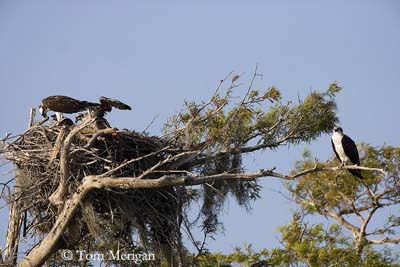
The chick hatching first is larger than the others. If the food is scarce, the smallest often dies. This process is named brood reduction. Both parents feed the young. Male brings food to female and chicks, about 3 to 10 fishes per day. One of the adults tears pieces from the fish to feed the chicks. Both parents feed and protect their young from predators and weather. Female broods them the first two weeks, and then, during bad weather.
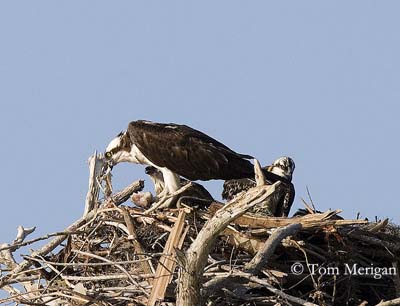
Chicks are covered in white down when they hatch, changing in dark brown down at about 10 days. Feathers need two weeks to replace down.
Young fledge between 50 to 75 days after hatching. They begin to hunt on their own, but parents continue to feed them at nest, for some weeks more.
Young reach their sexual maturity at about 3 to 5 years old.
This species produces one brood per year.
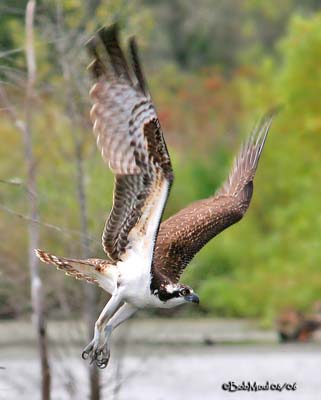
DIET:
Osprey feeds mainly on fish. But sometimes, it may consume birds, snakes, small rodents and salamanders.
